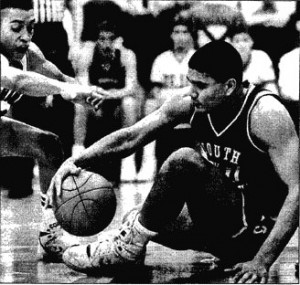Past Imperfect: Parrish Casebier Was All Wrong
Posted by JWeill on February 9th, 2012Past Imperfect is a series focusing on the history of the game. Every two weeks, RTC contributor Joshua Lars Weill (@AgonicaBoss|Email) highlights some piece of historical arcana that may (or may not) be relevant to today’s college basketball landscape. This week: the forgotten rise and fall of Evansville’s Parrish Casebier.
Things were never quite right with Parrish Casebier. Born in Owensboro, Kentucky to unmarried black parents, he was adopted at age two by a white family and brought across the Ohio River to live in tiny Rockport, Indiana, where he spent his youth struggling with being different. His younger sister was later adopted by the same family, and together they endured the taunts and bitter looks that came from neighbors, other kids and even some family.
Though he became a basketball standout at South Spencer High School, where he was the state’s second-leading scorer as a senior, even his own coach didn’t always like him. And at 6’3”, stocky, with short arms and little lift, Casebier was built all wrong for big-time college basketball. He was a forward with a guard’s size and a guard with a forward’s handle. In the world of Indiana high school basketball, Casebier’s muscle and will made him a star. But college coaches were mostly unimpressed.
Though Casebier could fill up the net, once scoring 49 points in a game two times in a mere two weeks, there was just something off. He talked back to coaches and got in fights almost daily. He skipped classes and all but dared the school to take away the one thing that made Casebier not just different but better. While further upstate Indiana-bound legend Damon Bailey was wrapping up his storybook prep career before heading off to play for Bob Knight at Indiana, Casebier was trying to earn a place on the state all-star roster or working out for mid-major college coaches.
Some of that lack of interest was due to Casebier’s size and lack of athleticism, but some of it, too, was an unspoken reputation for being a difficult kid, a kid with issues. But college coaches, especially at the lower levels, still take talent, even troubled talent, and Casebier clearly was one. So he picked the school that had first offered him a scholarship, the University of Evansville, over Western Kentucky and Indiana State. Schools like Evansville live off of under-recruited kids who don’t fit the profile that major colleges have for what a player is ‘supposed to be.’ And 6’3” power forwards are not supposed to be successful at the college level. The coach of the Purple Aces, Jim Crews, had been a longtime Knight assistant and he knew he was getting in Casebier a volume scorer who he would have to manage off the court. And for much of the time Casebier played in Evansville, things went fine, on the court.
Being different was something Casebier had adapted to, even if he hadn’t always done it willingly. Hardly an athletic marvel, Casebier instead relied on craftiness and shot fakes, often pumping three or even four times before shooting. The result was a school record for free throws attempted. There was some precedent for a game like Casebier’s. With his build, he offered a similar skill set to that of NBA star Charles Barkley, who was a capable but uncommon shooter from distance, and whose bulk belied his quickness and grit. But Casebier lacked Barkley’s otherworldly athleticism. And also his sense of self.
“He causes a lot of matchup problems,” Loyola of Chicago head coach Will Rey once said, “because he posts up. He scores on putbacks. He can shoot threes.”
As a freshman, Casebier averaged 15 points and 7.2 rebounds a game, not bad for an introduction to college ball, even in an off-the-radar conference nationally. The team was mediocre, but young, and the future looked bright indeed.
But before his sophomore campaign, the other side of Parrish Casebier also began to show itself. Before the season began, Casebier was one of several Evansville students caught in a textbook-selling scam and the soon-to-be basketball star was forced to sit out the first five games of the season. It was a trend of on-court/off-court swings that would manifest itself multiple times over the years, as was his generally dismissive response to being caught. It was, he told everyone, no big deal. They had singled him out because of his status. Read the rest of this entry »











































